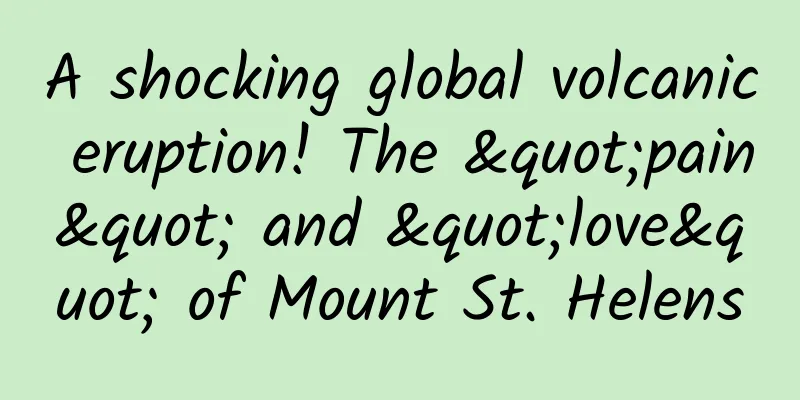A shocking global volcanic eruption! The "pain" and "love" of Mount St. Helens

|
If you ask which volcano in the United States is the most well-known, Mount St. Helens in Skamania County, Washington State, in the Pacific Northwest of the United States is undoubtedly the best choice. The past and present of this volcano are quite legendary. It is known as the "Mount Fuji of America" and has an altitude of about 2,549 meters. Mount St. Helens is a large conical layered active volcano on the Cascade volcanic chain in North America. It is also the most active modern erupting volcano in the Cascade Mountains. The composite volcanic cone of the volcano was formed 40,000 to 50,000 years ago. On the whole, the volcanic eruption and evolution process can be divided into ancient and modern stages. The ancient stage mainly erupted dacite and andesite, while the modern stage is mainly basalt, andesite and dacite. The eruption types of volcanoes are mainly explosive eruptions and Plinian eruptions, and the corresponding volcanic disasters are most obvious in volcanic ash and pyroclastic flows. Location map of Mount St. Helens in the United States (left, original map) and aerial view of Mount St. Helens (right, original map) Mount St. Helens has a rich eruption sequence, with more than 40 confirmed eruptions in the past 10,000 years, and a maximum Volcanic Explosivity Index (VEI) of 5. The eruption around 1860 BC was the largest eruption of Mount St. Helens during the Holocene. This eruption lasted until 1610 BC, depositing 46 cm of volcanic ash in Rainier National Park 80 kilometers away, and the volume of volcanic eruption products was about 10 cubic kilometers. It then experienced many eruptions over the next few thousand years, with eruption intervals of hundreds of years or even shorter, and the dormant period gradually shortened until the end of the volcanic activity in 1857, forming the current volcanic lava dome. The volcanic cone of Mount St. Helens before the eruption in 1980 (left picture, source from the Internet); after the eruption of Mount St. Helens on May 18, 1980, the lava dome on the top of the mountain was destroyed, forming a huge caldera (right picture, source from the Internet) There are always some signs of activity before a volcanic eruption, but the disasters caused by a volcanic eruption in reality are always far beyond people's imagination. The historic eruption of Mount St. Helens in 1980 confirmed this. In March 1980, the volcano began to show signs of awakening. Precursor phenomena such as earthquakes, jets, tremors, and deformations occurred continuously, and the north side of the crater expanded outward by more than 80 meters. Then on May 18, 1980, the United States ushered in the most destructive volcanic eruption in history (VEI=5). First, a 5.1-magnitude earthquake occurred on the north slope of the volcano. About 7-20 seconds later, a landslide was triggered, and the sliding part of the mountain slid down at a speed of 175-250 kilometers per hour. The landslide reduced the overlying gravity of the magma system and promoted the eruption of the volcano. The ash column produced by the eruption reached an altitude of 20-25 kilometers. In just a few hours, the eruption shaved off nearly 300 meters of the mountain's top, leaving a horseshoe-shaped crater (open to the north), and caused 2.5 cubic kilometers of rock debris to rush directly into the valley below, killing 57 people and destroying more than 200 homes and about 300 kilometers of roads. The giant volcanic cloud produced by the eruption of Mount St. Helens on May 18, 1980 (left); thick volcanic ash covering the sky (center); homes and roads near the volcano were destroyed (right, all pictures are from the Internet) People who witnessed the eruption described it as "hell on earth". After the volcano began to wake up in March 1980, Dr. David A. Johnston, a volcanologist from the United States Geological Survey (USGS), believed that the volcano would erupt in a short time based on volcanic monitoring research data, and suggested that the authorities evacuate workers and residents around the volcano in advance, thus saving thousands of lives. With his loyalty and persistence in volcanic monitoring, volcanologist Johnston continued to carry out relevant monitoring work at the volcano observatory about 8 kilometers away from the crater the night before the volcanic eruption on May 18. On the morning of the volcanic eruption, Johnston conducted deformation measurements on the uplift area on one side of the volcano. Because the volcanic eruption was too violent, he also died in the eruption. Volcanologist Johnston used his perseverance and dedication to provide future generations with precious on-site monitoring data of the Mount St. Helens eruption. His love for volcanoes is as hot as magma. As described in the documentary "Volcano Love", "Because of love, I ran to it without hesitation." Johnston conducted volcano monitoring work at the Volcano Observatory on May 17, 1980 (Photo from the Internet) Volcanoes are beautiful but also dangerous. They can be reborn from destruction, and they can be destroyed again from rebirth. Volcanoes can bring gifts to mankind, but they will also inevitably bring disasters. Only when generations of volcano science and technology workers continue to improve the monitoring, prediction and early warning system can we make the harmonious coexistence of volcanoes and humans a future that is within reach. Documentary "Volcano Love" (Photo from the Internet) This issue of science popularization ends! Friends, see you next time! References in this issue: [1] Li Mengmeng, Gu Guohui, Guan Sheng, et al. Comparison of geological background similarities between Tianchi Volcano and Mount St. Helens in Changbai Mountain[C]. Seismological and Geomagnetic Observation and Research, 2022, 43(S1): 70-72. [2] Hong Hanjing, Liu Hui, Research on the state and mechanism of volcanic activity[J]. Seismology and Geology, 2007, 29(3): 502-512. [3] Gregory P. Waite, Seth C. Moran. VP Structure of Mount St. Helens, Washington, USA, imaged with local earthquake tomography[J]. Journal of Volcanology and Geothermal Research, 2009, 182: 113-122. [4] Lipman, PW, Mullineaux, DR (Eds.). The 1980 eruptions of Mount St. Helens, Washington[R]. Washington, DC: US Government Printing Office, 1981, 1250, p.844. [5] William PL, Diane RS The role of magma mixing, identiffcation of maffc magma inputs, and structure of the underlying magmatic system at Mount St. Helens[J]. American Mineralogist, 2018, 103: 1925-1944. Authors of this issue: Song Yujia, Sun Liying, Sveva R.M. Planning: Xu Zhitao, Nikos·S, Ye Xiqing, Fabio·S Editor: Gu Guohui and Li Mengmeng Review: Pan Xiaodong, Kang Jianhong, Cao Li, Chen Bo, Li Zhongwei, Chen Junjie, Zheng Guodong, Lu Yanhong, Wen Hongtao, Pang Jingyuan Publicity: Guan Sheng, Zhu Daqing, Han Di, Yan Donghan, Ma Fei, Wei Meixuan, Zhang Renpeng, Li Yihong Produced by: Institute of Volcanology, China Earthquake Administration, Jilin Province Earthquake Administration, Italian Institute of Geophysics and Volcanology, Catania Volcano Observatory, Italy, Vesuvius Volcano Observatory, Italy Disclaimer: All pictures and texts in this article are for public benefit and do not have any commercial value. |
>>: Don’t be fooled again! Have you fallen into the trap of eyewash?
Recommend
Low blood pressure is common among women. Does it have any impact on health? What should we do?
A friend asked Huazi why he always talked about h...
There are five levels of operator realm. Which level are you at?
We who practice martial arts... um, no, it's ...
Given a scenario, can Alipay recreate an Alibaba?
In the past few days, we have witnessed a miracle...
The secret of down jackets to keep warm can no longer be hidden
Produced by: Science Popularization China Produce...
Luckin Coffee brand promotion strategy!
In April 2019, Luckin Coffee launched four types ...
There is a dragon named "Zhu Po" - the prototype of the dragon is the Yangtze alligator?
2024 is the Year of the Dragon in the lunar calen...
What programmers must know about the evolution of the front-end
After carefully sorting out the front-end technol...
The only survivor of Jixi sour soup poisoning has passed away. How long can sour soup be preserved?
The "sour soup" poisoning incident that...
The current situation of iOS buying volume market and advertising matters!
As we all know, Android has a large number of use...
Useful Information | What does a high-conversion information flow ad look like?
For information flow advertising , the content an...
How long does it take to record the video of the African mercenary child shouting and holding a sign?
Please add customer service WeChat (Wechat): 1867...
How to attract fans born in the 90s? Successful brands are using these 5 strategies
Trying to label young people may seem lazy, but i...
Why is it necessary to do nucleic acid testing for dynamic zero-COVID, and do it again and again?
The novel coronavirus has been raging on the worl...
The most powerful growth method for user retention
What is a behavioral model? In fact, it is a habi...









